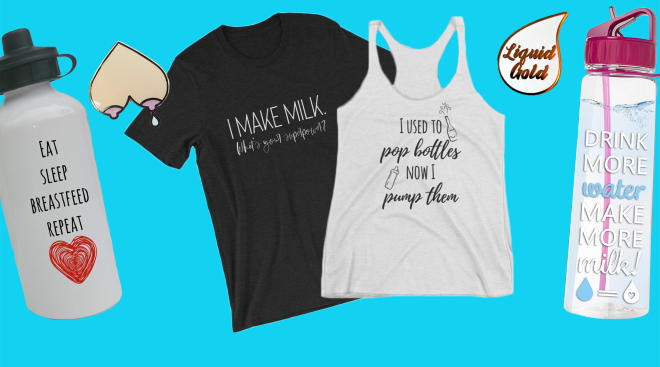What to Expect at Each Stage of Breastfeeding
When you’re pregnant, you might assume that after baby arrives, you begin breastfeeding (if that’s what you’re planning to do) and that’s that—but in fact, breastfeeding is an evolving journey that changes (for you and for baby) at each stage. Did you know your body actually starts producing breast milk mid-way through pregnancy, and that breast milk composition changes to keep up with baby’s needs after birth? Here, we asked experts for the low-down on what to know about each stage of breastfeeding, from start to finish, and how it changes as baby grows.
Regardless of how you delivered, your body is ready to start breastfeeding immediately after birth. That’s because your body actually starts producing colostrum—the first form of breast milk—about halfway through pregnancy. Colostrum is a thick, yellowish milk that’s calorie-dense and filled with nutrients for baby. “It’s also high in important immunoglobulins, which line a newborn’s tummy and play an important role in building immunity for the baby,” says Carrie Bruno, RN, IBCLC, a lactation consultant and founder of The Mama Coach. This stage is called Lactogenesis I, which refers to the process of making milk. Your body will continue to make colostrum for the first few days after birth.
During this time, newborns usually nurse around eight to 12 times within a 24-hour period, Bruno says, although it can be normal for them to nurse more than that. A lot of new parents tend to stress over how long baby nurses for per feeding, but there aren’t any rules about how long breastfeeding sessions should last. “There are some babies that are very quick feeders right from the start, and some that eat slower all the way through breastfeeding,” explains Molly Petersen, a certified lactation counselor with Lansinoh. The American Academy of Pediatrics (AAP) notes that each breastfeeding session can last anywhere from 10 to 45 minutes, but this varies too. “For some, a full feed is 5 minutes, for some it’s 20 or more minutes,” Bruno says. It can be a good idea to track feedings for your pediatrician, but as long as baby is nursing and otherwise healthy, try not to worry about how long they’re feeding for.
Often, one of the more stressful aspects of this stage of breastfeeding is getting baby to latch well. A latch refers to how baby attaches to your nipple to nurse—and it’s important to establish a proper one early on, since it helps baby get the most milk and ensures that breastfeeding is comfortable for you. (Head here for pro tips on how to nail a perfect latch.) You may experience temporary nipple pain as baby adjusts their latch, says Tovah Haim, founder of Bodily. Plus, it may take you a day or two to get used to the sensation of baby nursing and figure out the most comfortable and effective breastfeeding positions for you and your little one. Remember that it’s a learning curve for both of you, and it’ll take some practice. “After baby is born, nursing is brand new! It’s a learned skill from both baby and mom and can be slightly uncomfortable as you adjust,” Bruno says. “Breastfeeding is a very natural process, but natural and easy are not synonymous. Women should not feel shame if they are struggling to establish nursing.” If baby’s unable to establish a proper latch or if it hurts to breastfeed, reach out to your health care provider or a lactation consultant who can get you both on track.
While baby learns how to nurse, you can try hand expressing or pumping breast milk. New moms can also supplement with formula, Bruno says, but this is really only necessary if baby is losing birth weight and is slow to regain it. If you do end up needing to supplement with formula, that’s totally okay—and it doesn’t hurt your chances of successfully breastfeeding. “There are tons of parents who supplement at the beginning and go on to exclusively breastfeed,” she says. “The key is support.”
After the first few days of producing colostrum, your body will begin making transitional breast milk, which is thinner and whiter than colostrum. This is when your milk “comes in,” a phase known as Lactogenesis II. It also contains more fat, proteins, vitamins and lactose (aka carbohydrates). Your body will continue to produce transitional breast milk for up to two weeks after birth.
During this phase of breastfeeding, engorgement is common due to the increase in breast milk volume as your milk comes in. Simply put, this means your breasts are full with milk and may feel sore, swollen and hard to the touch. “Engorgement is basically happening because your body’s trying to figure out how much milk it needs to produce, and your baby is growing pretty rapidly,” says Haim. These early weeks of breastfeeding are when engorgement is most prevalent, but it usually passes within 24 to 48 hours after milk comes in, Bruno notes.
As your body establishes a milk supply, it’s important to understand that breastfeeding works on a supply-and-demand basis. Research shows that the more baby nurses (signaling to your body that they’re hungry and need more milk), the more milk your body will produce. To help establish and maintain your supply, the AAP recommends that you breastfeed on demand (meaning nurse baby whenever they’re hungry), or pump whenever baby gets a bottle. Otherwise, skipped nursing sessions can indicate to your body that it doesn’t need to make as much milk, and your supply may dip.
During the first couple of weeks, with baby nursing up to 12 times a day, it may feel like you’re nursing around the clock. But much of this depends on your milk flow and how efficiently baby is able to drink, Bruno says. Nursing patterns will stabilize as you and baby both get into a rhythm. “Babies get more efficient at nursing as they grow, but timing varies from baby to baby and mom to mom,” Bruno explains. “I always tell families not to watch the clock, but rather their baby.”
Wondering how to tell when baby is full? At the start of the feed baby will likely be alert and actively trying to latch on, Petersen explains, but as they start to fill up, they’ll become more mellow and draw less frequent pulls of milk. “At the end of a feed, when baby has received enough to eat, they’ll usually unlatch and refuse to relatch when offered the breast again,” she says. “They may even fall asleep and become unlatched as they drift off.” It’s important to note babies sleep a lot in the first few weeks—sometimes even during a feed. It can be hard to trust baby’s getting enough milk, especially when you can’t see how much milk they’re taking in. Both Bruno and Petersen say that when baby takes big swallows during the feed, it’s a signal that they’re getting the milk they need, even if they drift off or only nurse for a few minutes.
The most important thing to remember during these first couple of weeks? Be kind to yourself, and ask for help when you need it.
Around two weeks postpartum, transitional milk changes into mature breast milk. This is known as Lactogenesis III and refers to the stage of established breastfeeding. By now, you and baby have probably found your groove, and things are feeling more comfortable. “Women will stay here as long as they continue to breastfeed, whether that is a month or for years,” Bruno says. The AAP recommends new mothers exclusively breastfeed baby for the first six months and then continue to nurse while supplementing with solid foods—but ultimately, how long you breastfeed for depends what’s best for both you and baby.
Mature breast milk is often lighter in color, but its composition can change from day to day, depending on baby’s needs. “For example, if Mom or baby is sick, her breast milk will increase in white blood cells to help fight off the infection,” Bruno explains. “Mature milk can also change from feed to feed and within the feed itself.” She cites ‘foremilk’ and ‘hindmilk’ as two examples, explaining that foremilk is higher in carbohydrates and present in larger quantities at the start of each breastfeeding session, while hindmilk is higher in fat and increases in quantity as the feeding progresses, helping baby feel nice and full.
There are a handful of issues you might experience at some point during this stage of breastfeeding:
Cluster feedings
Cluster feedings occur when your newborn seems hungry all the time, wanting to be fed in rapid “clusters” throughout the day. According to the AAP, this could be a result of growth spurts, which typically happen around three weeks, six weeks and three months postpartum. “Babies will often want to feed more frequently to get the calories they need to fuel their growth,” Petersen says. “Breastmilk supply will also increase during these times in response to more frequent feedings.” Cluster feedings may also happen if baby has been separated from you for a period of time, she adds. Don’t forget to hydrate and fuel your own body too, as it needs extra calories and energy to produce milk, says Michelle Smith, a newborn care and lactation educator with Owlet Care. This is important throughout breastfeeding, not just during baby’s growth spurts.
Clogged ducts and mastitis
Unfortunately engorgement isn’t the only discomfort that may accompany breastfeeding—you might also experience a clogged milk duct. This occurs when breast milk is stagnant or backed up, causing the large, fatty molecules it contains to clot. “Your breasts are a network of teeny tiny tubes. Those clots can get stuck going through the tubes, which is a clogged duct,” Haim explains. If a clogged duct isn’t resolved quickly, it could lead to mastitis, which is when your breast tissue becomes inflamed and infected. Clogged ducts and mastitis can be very painful, Haim notes. Luckily, many of the main causes of clogged ducts and mastitis—such as tight bras and a poor latch—are easily fixable, she adds.
Your first menstrual period postpartum
Odds are, you might not get your menstrual period for the first three to six months postpartum—or longer, Smith says. This is due to a hormone called prolactin, which helps with milk production and stops eggs from becoming mature and fertilized. When you do get your first period after pregnancy, it may cause an initial dip in your supply due to hormonal changes, Petersen and Smith explain, but supply should regulate and return to normal as your hormones balance out.
Thanks to childbirth recovery and fluctuating hormones, those initial few weeks of breastfeeding can be a whirlwind. Thankfully, it does get easier as you and baby find your rhythm. “Once you get past that six month mark, it starts to become pretty easy and seamless,” Haim says. While mastitis and engorgement can still happen, both should be less frequent, she notes.
When baby is around 6 months old, you’ll likely begin to introduce solid food into their diet as a complement to breast milk—and you might notice a decrease in breastfeeding sessions and your milk supply as a result. This is to be expected, but the AAP recommends continuing to breastfeed whenever baby wants to keep up your supply. (Remember, breast milk is still baby’s primary form of nutrients at this point.) If you’re left with an oversupply and feel engorged, hand-express milk to ease any breast discomfort, Smith says. Rest assured, as your body starts to learn baby’s changing breast milk needs, your supply will adjust accordingly. “Gradually introducing solids can help with the adjustment your body needs to make to the demand in breast milk,” Smith explains.
The end of the breastfeeding journey is referred to as weaning, or Lactogenesis IV, Bruno explains. “This stage typically lasts 40 days from your last breastfeeding session and is when milk production ceases.” According to the AAP, letting your child dictate when to wean is often most simple, and it may naturally start to happen once other forms of nutrition and comfort are introduced. Of course, you may also choose to start weaning for your own reasons. Ultimately, deciding when and how to stop breastfeeding is a personal decision that will vary between families. However, experts agree that when it’s time, it’s best to wean slowly to ensure the process is as seamless and painless as possible for both parties. “If you stop breastfeeding suddenly, it can cause engorgement, plugged ducts and potentially mastitis,” Petersen says. If you can, “wean gradually [by] removing one feeding or pumping session at a time and allow several days for your body to adjust before you remove another one.”
At the end of the day, breastfeeding can look and feel different from person to person. While there’s a general trajectory of how the stages of breastfeeding unfold, how easy or enjoyable it is varies. You know your family best and are most equipped to decide how your breastfeeding journey will play out.
About the experts:
Carrie Bruno, RN, IBCLC, graduated from nursing school at MacEwan University in Edmonton, Alberta, Canada in 2005. She worked as a labor and delivery nurse for 10 years before starting her own company, The Mama Coach, in 2015. In the past six years, the Mama Coach has grown to a global team of registered nurses that provide prenatal education, newborn support, lactation counseling, sleep coaching and allergy navigation.
Tovah Haim, is the founder of Bodily, an online platform for resources and products relating to pregnancy and the postpartum period. Haim launched the brand following the birth of her first child in 2017, pivoting from a career in finance to a career in women’s health. Haim holds a bachelor of arts degree in political economy from the University of California, Berkeley.
Molly Petersen, CLC, is a certified lactation consultant with Lansinoh, a brand that provides breastfeeding products and support. She attended the University of Nebraska Omaha, and completed her lactation certification at the Academy of Lactation Policy and Practice.
Michelle Smith is a certified sleep specialist, as well as a newborn care and lactation educator. She is a core expert with baby brand Owlet Care. Smith received her bachelor of applied science degree from the University of Utah.
Please note: The Bump and the materials and information it contains are not intended to, and do not constitute, medical or other health advice or diagnosis and should not be used as such. You should always consult with a qualified physician or health professional about your specific circumstances.
Plus, more from The Bump:
Navigate forward to interact with the calendar and select a date. Press the question mark key to get the keyboard shortcuts for changing dates.





















































